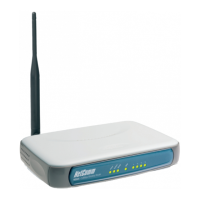
Do you have a question about the NetComm Wireless Router NB504 and is the answer not in the manual?
| Device Type | Wireless Router |
|---|---|
| Frequency Band | 2.4GHz |
| Maximum Wireless Speed | 150Mbps |
| Ethernet Ports | 4 x 10/100Mbps |
| WAN Port | 1 x 10/100Mbps |
| Security | WEP, WPA, WPA2 |
| Wireless Standards | 802.11b/g/n |
Explains the guide's objective: how to use the NB504 54Mbps Wireless Router.
Clarifies that "router" in the guide refers to the NB504 54Mbps Wireless Router.
Provides a summary of the user guide's chapters and appendices structure.
Introduces the NB504 router, its integrated features, and its purpose for SOHO networks.
Lists the key technical specifications and capabilities of the NB504 54Mbps Wireless Router.
Describes the physical ports and indicators on the router's panels for user reference.
Lists the necessary hardware and software prerequisites for connecting the router.
Specifies optimal conditions for placing and operating the router to ensure performance.
Provides step-by-step instructions for physically connecting the NB504 router to the network.
Explains how to configure TCP/IP settings on a PC for router connectivity, including DHCP or static IP.
Guides users through the initial web-based setup process for the router.
Details how to access and log into the router's web-based utility for configuration.
Describes how to view the router's current operational status and network configuration.
Outlines the simplified setup wizard for basic network parameter configuration.
Covers configuration settings for LAN, WAN, and MAC cloning.
Details configuration for wireless network settings, security, and statistics.
Explains DHCP settings, client lists, and IP address reservation for network management.
Covers port forwarding features like Virtual Servers, Port Triggering, and DMZ.
Details security features including Firewall, IP/Domain/MAC filtering, and advanced settings.
Explains how to bind IP addresses to MAC addresses for network security.
Details how to configure static routes for specific network traffic paths.
Covers the setup of Dynamic Domain Name System services for domain resolution.
Provides access to system utilities for time, firmware, defaults, backup, reboot, password, and logs.
Explains how to configure the Local Area Network (LAN) settings, including IP address and subnet mask.
Details the configuration options for the Wide Area Network (WAN) connection type.
Describes how to copy a PC's MAC address to the router's WAN port for ISP requirements.
Covers essential wireless network parameters such as SSID, security type, and channel.
Explains how to control wireless access based on device MAC addresses for enhanced security.
Displays statistics for connected wireless stations, including MAC address and packet counts.
Details the configuration of the Dynamic Host Configuration Protocol (DHCP) server.
Shows a list of devices currently assigned IP addresses by the DHCP server.
Allows reserving specific IP addresses for devices on the LAN.
Explains how to set up virtual servers to make LAN services accessible from the Internet.
Describes how to configure port triggering for applications requiring dynamic port mapping.
Details the DMZ host feature for exposing a local device to the Internet for specific services.
Explains the Universal Plug and Play (UPnP) feature for automatic network device discovery.
Covers enabling and configuring the router's built-in firewall for network protection.
Details how to control Internet access based on specific IP addresses.
Explains how to block or allow access to websites based on domain names or keywords.
Describes how to control network access by filtering based on MAC addresses.
Details how to configure the router for remote access and management over the Internet.
Covers advanced security features like DoS protection and ping filtering.
Explains how to bind IP addresses to MAC addresses for network security.
Displays the ARP list, showing the relationship between MAC and IP addresses on the LAN.
Details how to configure static routes for specific network traffic paths.
Covers the setup of Dynamic Domain Name System services for domain resolution.
Provides access to system utilities for time, firmware, defaults, backup, reboot, password, and logs.
Details the process for upgrading the router's firmware to the latest version.
Explains how to restore the router to its original factory default settings.
Describes how to save and restore router configuration settings.
Guides on how to reboot the router to apply settings or resolve issues.
Explains how to change the default administrator username and password for security.
Covers how to view and manage system logs for monitoring router activity.
Displays network traffic statistics for connected PCs on the LAN.
Provides instructions for setting up the router for ADSL internet connections using PPPoE.
Guides on configuring the router for Ethernet internet access, including MAC cloning.
Explains how to configure Virtual Servers or DMZ Host for Netmeeting functionality.
Offers troubleshooting steps for resolving issues with wireless clients connecting to the router.
Instructs on installing the TCP/IP protocol component in older Windows versions.
Details how to configure TCP/IP settings (DHCP or static IP) on a PC for network access.